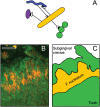Stick to your gums: mechanisms of oral microbial adherence
- PMID: 21335541
- PMCID: PMC3188457
- DOI: 10.1177/0022034511399096
Stick to your gums: mechanisms of oral microbial adherence
Abstract
Studies on the adherence properties of oral bacteria have been a major focus in microbiology research for several decades. The ability of bacteria to adhere to the variety of surfaces present in the oral cavity, and to become integrated within the resident microbial communities, confers growth and survival properties. Molecular analyses have revealed several families of Gram-positive bacterial surface proteins, including serine-rich repeat, antigen I/II, and pilus families, that mediate adherence to a variety of salivary and oral bacterial receptors. In Gram-negative bacteria, pili, auto-transporters, and extracellular matrix-binding proteins provide components for host tissue recognition and building of complex microbial communities. Future studies will reveal in greater detail the binding pockets for these adhesin families and their receptors. This information will be crucial for the development of new inhibitors or vaccines that target the functional regions of bacterial proteins that are involved in colonization and pathogenesis.
Figures


References
-
- Amano A. (2010). Bacterial adhesins to host components in periodontitis. Periodontol 2000 52:12-37 - PubMed
-
- Amano A, Kuboniwa M, Nakagawa I, Akiyama S, Morisaki I, Hamada S. (2000). Prevalence of specific genotypes of Porphyromonas gingivalis fimA and periodontal health status. J Dent Res 79:1664-1668 - PubMed
-
- Asakawa R, Komatsuzawa H, Kawai T, Yamada S, Goncalves RB, Izumi S, et al. (2003). Outer membrane protein 100, a versatile virulence factor of Actinobacillus actinomycetemcomitans. Mol Microbiol 50:1125-1139 - PubMed
-
- Beevi L, Hedge S, Kashyap R, Kumar A. (2009). Vaccines and periodontal diseases—an insight. Dent Update 36:635-638 - PubMed
Publication types
MeSH terms
Substances
Grants and funding
LinkOut - more resources
Full Text Sources
Other Literature Sources
Molecular Biology Databases

